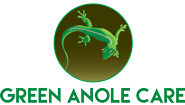Choosing Your Anole:
Choose a healthy Anole. It should be active and have no visible injuries or fecal discharges from the vent. Small reptiles are difficult (and expensive) to treat. You aren’t doing the Anole a favor by “rescuing” it. With a slow metabolism, by the time the serious symptoms appear, it is often too late for treatment.
Shedding:
Anoles shed when their skin is restricting their growth. The interval depends on their age and eating habits. They will usually have a dull appearance just prior to the shed. White patches resembling blisters will appear and the skin will then begin to slough off. Anoles are master recyclers. They eat the skin as it is shed to reuse the nutrients. Shedding usually takes about an hour and they might even do it in stages with the head or body first followed in a couple of days by the other body part. Unshed bits of skin are NOT a problem UNLESS they are constricting a limb or other appendage. You may be able to remove the problem bits by GENTLY rubbing the dry skin with a Q-tip soaked in warm water. NEVER forcibly pull off a bit of unshed skin!
Lifespan and Health issues:
Small/medium Anoles live 4-6 years routinely in captivity. That is longer than mice, rats, gerbils, and hamsters. Large species live 10-15 years. So you have a long-term commitment.
Minor cuts and abrasions can be treated with human medications. For example, Neosporin will keep a wound from becoming infected and eye drops will take care of eye infections.
Mites can be treated with one of the commercial miticides designed for reptiles. Just follow the directions on the package. Mites appear as reddish or white specks that move about on the Anole’s body.
Two serious health issues are Metabolic Bone Disease (MBD) caused by a calcium deficiency, and prolapses. Anoles need UVB to synthesize calcium. A calcium deficiency results in curved spine, deformed limbs, and nerve damage. It is preventable by providing the correct lighting and dusting the prey items with a calcium supplement.
Prolapses are a condition where either the intestines or reproductive organs protrude from the vent. A prolapse is usually fatal and virtually untreatable in all but the largest species.
Another is mouth rot. The mouth will become black. It is usually the result of a cut or injury sustained during eating. Take the Anole to a vet immediately.
Anoles will sometimes get respiratory infections as well. The symptoms are gaping and strenuous breathing with the mouth open. Raise the temperature to an overall 85+ degrees in a QUARANTINE enclosure. If things don’t improve in a day or so, see a vet.
Anoles sometimes have a white powdery substance around their nostrils. This is how they normally excrete excess salt in their bodies. It is completely normal and no cause for alarm.
Postorbital eyespots are used to express extreme anger or stress. These black spots frequently appear in males during Aggressive/Challenge displays. If they don’t go away in 20 minutes or so or if they are present in a female, they are cause for alarm.
Mixing species:
The simple answer is: DON’T MIX SPECIES! Even two species of Anoles should NOT be kept in the same enclosure. Why? Besides that fact that different species generally have different environmental requirements, each reptile species has its own parasite load. Some are beneficial and some are harmful but all reptiles and amphibians have some microbe or parasite living in their digestive tract. What is completely benign and innocuous to one species might very well be fatal to another. If you mix species, you will shorten the lifespan of both.
Euthanization:
Should you be in the unfortunate position of having to euthanize a terminally ill anole, the most painless and quickest method is cranial destruction. If you are adept at “pithing” a small reptile(i.e., inserting a needle into the brain at the base of the skull), you can use that method. Otherwise hammer or brick serves the same function. It is much more humane than freezing or even lethal injection.
